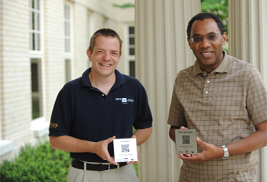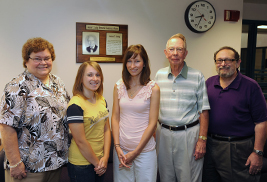Featured Article
Kent State Department of Sociology Dedicates Dr. James T. Laing Memorial Conference Room
To pay tribute to his father and provide a permanent legacy, Kent State University alumnus Tom Laing, ’55, ’56, and his wife, Barbara, made a recent gift to name the conference room in the Department of Sociology in memory of Dr. James T. Laing, the first chair of the department.
read moreKent State Partners With Elementary Students and Historical Society on GeoHistorian Project
Posted Aug. 29, 2011
Mark van ‘t Hooft (left) and Thomas McNeal (right) of Kent State’s Research Center for Educational Technology display examples of QR codes from their GeoHistorian project.
Kent State University’s Research Center for Educational Technology collaborated with fifth-grade students at Walls Elementary School and the Kent Historical Society to share the history of 11 Kent city landmarks through digital storytelling. Funded by a grant from the National Endowment for the Humanities, the GeoHistorian project was spearheaded in the fall 2010 by Mark van ‘t Hooft and Thomas McNeal, center staff members.
The project connected the university with local students to create historical videos that can be accessed through a smartphone via a QR code reader. A QR code (short for Quick Response Code) is an assortment of black squares on a white background that can be scanned by a camera phone. Once the two-dimensional barcode is scanned, it will take the user to a specific website, or in this instance, a historical video created by students.
The QR codes are engraved on small metal signs and installed at Kent city sites for which students created a digital story. Some of the locations include the Erie Depot, the former Erie Shops, the Silk/Alpaca Mill, the Kent Free Library and the new home of the Kent Historical Society.
“We are working with local teachers to continue the project with a second set of stories,” says van ‘t Hooft. “We also hope to develop a program where visitors who watch the videos will receive stamps for a GeoHistorian passport.”
The mission of Kent State’s Research Center for Educational Technology is to explore the uses and influences of technology in education through rich collaborations among researchers and practitioners, to help improve teaching and learning in today’s classrooms and to inform the development of ubiquitous computing environments of the future.
For more information about this project, visit www.rcet.org/geohistorian.
